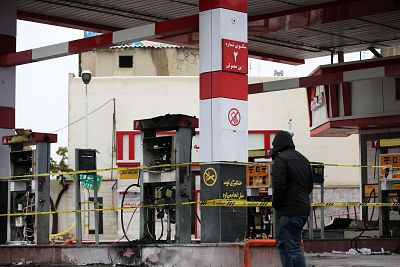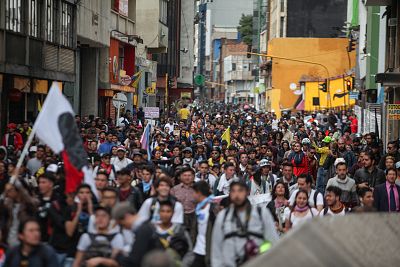Protests created a domino effect, crossing borders and bringing droves of people to streets around the world.
In 2019, demonstrations around the world, both peaceful and violent, were set off by social unrest over economic instability, government corruption and inequality. The protests created a domino effect, crossing borders and bringing droves of people to streets globally to demand change. The desire to be heard was felt by people from different nationalities, religions and political affiliations.
In Hong Kong, a bill that would allow extradition of suspects to mainland China sparked months of massive anti-government protests that continued even after the bill was withdrawn by Chief Executive Carrie Lam. Six months later, demonstrations that are ongoing have escalated to pro-democracy protests, primarily led by students, in defiance of the Chinese government.
June 16 marked the largest protest in the country's history, peaking at 2 million people. "We can see people getting united, and then they all stand together as one," protester Alsace Cheung told NBC News as demonstrations turned increasingly violent.
Toward the end of the year, riot police laid siege to a university, where 500 students were believed to be trapped inside. Water cannons and heavy police vehicles surrounded the areas outside the campus, while demonstrators retaliated from inside, wielding Molotov cocktails and arrows.
As of mid-December, Hong Kong police continue to call for the public's cooperation "to put an end to all rioting acts and to bring offenders to justice," following violent clashes and mass destruction of properties that resulted in 99 arrests over one weekend. In one particularly violent incident in November, protesters set a man alight outside a subway station.
Meanwhile in 2019, the Middle East also saw tensions that broke out into protests.
In Iran, civil unrest shook the streets after a strike over rising gasoline prices escalated into one of the deadliest uprisings since the Islamic Revolution 40 years ago. An estimated 304 people were killed when the state retaliated against protesters, according to Amnesty International, and the U.S.'s special representative to Iran Brian Hook told reporters in December that the U.S. estimated that more than 1,000 may have been killed in the protests.
Iran's government, which has said it is investigating the deaths, disputes those estimates of fatalities but hasn't released numbers itself.
Iraq faced a similar turmoil led by the youth and lower-income residents who demanded an end to corruption, high unemployment and weak infrastructure. The United Nations Commission on Human Rights condemned what it described as anexcessive use of force, particularly the use of live ammunitions. The death toll from the response was reportedly at least 354 people, but the U.N. believes the real figure is likely higher.
Iraqi Prime Minister Adel Abdul Mahdi resigned in late November in response to the popular disapproval fueled by a desire for political change.
In contrast, Lebanese demonstrations brought together an often-divided public in a rare but hopeful sign of unity. A proposed fee on internet voice calls triggered protests from crowds of different sects and religions, waving Lebanese flags.
Several hundred thousand young, leaderless protesters asked for economic reform and equality and for an end to government corruption. The peaceful protests quickly escalated to nationwide demonstrations that paralyzed the country for weeks, and prompted Lebanese Prime Minister Saad Hariri's resignation in October.
In South America, "cacerolazo" protests — consisting of the banging of pots and pans — echoed in several countries in response to unrest over weak political systems.
Chile, a country known for maintaining one of the most stable democracies in the region, was at the forefront of South American protests this year.
Demonstrations, mostly driven by students, erupted from a 4-cent subway fare hike in October and quickly turned into violent clashes between security forces and protesters. People set several subway stations on fire and looted supermarkets and churches. Authorities did not hesitate to retaliate.
"We are united in our indignation for the abuses brought about by the government and the business sector," activist Mathias Lueg said from the streets of Santiago. The government was forced to cancel two major international summits — the Asia Pacific Economic Cooperation summit and the United Nations climate summit — as Chile's National Institute of Human Rights attributed at least 20 deaths and thousands injured to the riots.
In Colombia, tens of thousands of anti-government protesters demanded the resignation of President Iván Duque Márquez over what started as a planned labor union strike and transformed into widespread uproar on behalf of the opposition.
Amid the demonstrations, Colombia's capital of Bogotá was placed under a curfew — the first of its kind in decades — and riot police dispersed protesters with tear gas after three people were killed. The Popular Human Rights Network of Bogotá denounced the use of unconventional weapons against protesters.
The historic upheaval in Bolivia that led President Evo Morales to resign and flee to Mexico ignited a severe political conflict in the nation. The claims of election fraud after his October win sent Bolivians to the streets, turning into clashes between rival protesters.
The widespread tensions escalated when security forces stepped in, killingat least 17 people and arresting 600 protesters, according to the United Nations.
Since the president's resignation, more protests have soared calling for his return. While the opposition celebrated his departure, Morales still has solid support back home who fear the power vacuum.
Venezuela also saw a power struggle at the beginning of this year. Ongoing protests in Venezuela, led by opposition leader Juan Guaidó, began with Nicolas Maduro's second inauguration in January. Amid the economic collapse, the country's humanitarian crisis has reached a breaking point, capturing the world's attention and leading the international community, including the United States, to take a hard stance against Maduro.
However, protests have faced a decline in recent months as many believe Guaidó missed his moment to lead the country out of turmoil. Protesters claim the inability of the opposition to unite, and settle on actions rather than dialogue, has further deepened this crisis.
And these are just a few of the many countries that saw large demonstrations of civil disobedience this year. In addition to Hong Kong, the Middle East and South America, the "Yellow Jacket" movement in France, anti-government protesters in Pakistan, political activists in Russia, university students in India and kids worldwide fighting climate change were other examples of protest movements.
While this isn't a comprehensive list, 2019 clearly brought with it widespread demands for change and government accountability throughout the world, and NBC News was there, at ground zero, in many of those instances.













